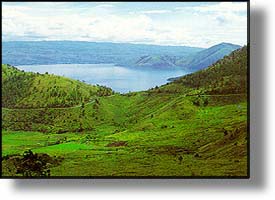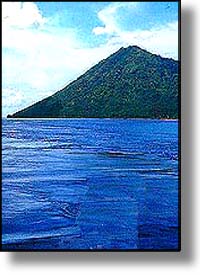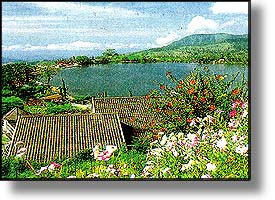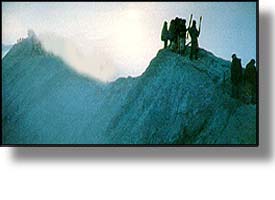Indonesia
Indonesia
Homepage | Indonesia's
History
Asia Homepage | The
World
Sumatra
 Indonesia's largest and least developed province, Sumatra rests
along the equator, heavily forested and rich in rare wildlife.
The island's slow development has made it ideal for eco-tourism,
and numerous large reserves and preservation areas have
been set aside. Its most famous park, Mount Leuser National Park,
is one of the last refuges of the Sumatra Orang-Utan. Indonesia's largest and least developed province, Sumatra rests
along the equator, heavily forested and rich in rare wildlife.
The island's slow development has made it ideal for eco-tourism,
and numerous large reserves and preservation areas have
been set aside. Its most famous park, Mount Leuser National Park,
is one of the last refuges of the Sumatra Orang-Utan.
Another distinguished
park is the Berbak Wildlife Reserve, which has one of Indonesia's
largest tiger populations. In the far north of the island
is Lake Toba, an enormous and extraordinarily
beautiful crater lake.
A particularly enthralling adventure
experience in Sumatra takes place on the Alas River, which
winds its across North Sumatra through jungle, limestone
gorges, and native villages. The voyage begins in the Karo
Highlands and culminates with the Indian Ocean: a descent
ten times that of the Grand Canyon's Colorado River.
Bali
Bali is an island where art
and religion mingle in the daily lives of people in a way
unlike anywhere else on earth. Its culture overflows from
its temples and into the streets, where artisans of every
kind continue traditional methods of handicraft that have
been passed down for generations.
This cultural concentration
in Bali can be traced back to the 14th century, when Islam
expanded in force across the nearby island of Java, pushing
the Hindu Majapahit court across the water to Bali and effectively
making it an isolated haven for Indonesian Hinduism. The
most famous of the many Balinese cultural traditions are
its poetic and ornate dances, which employ a graceful and
highly-sophisticated gestural language to narrate traditional
stories and legends.
Bali's natural beauty is as
startling as its cultural riches. Bali Barat National Park,
which dominates the entire west end of the island, is home
to one of the world's rarest and most beautiful birds. The
beaches of Bali are world famous. Many are ideal for surfing,
and plenty of offshore reefs create good scuba diving environments.
Sulawesi
 With four huge peninsulas stretching
out haphazardly into the South Pacific, Sulawesi's infamous
shape has often been compared to that of a spider or an
amoeba. The island lies just east of Kalimantan and north
of Bali. With four huge peninsulas stretching
out haphazardly into the South Pacific, Sulawesi's infamous
shape has often been compared to that of a spider or an
amoeba. The island lies just east of Kalimantan and north
of Bali.
The island is divided into two
regions, north and south, with its key city, Unjung Padang,
situated on the island's southwestern leg. North Sulawesi
and its [link]Bunaken Marine Park[link] is best known as
Indonesia's mecca for divers and snorklers, while South Sulawesi
harbors two of the country's most interesting cultures. In
the far south, in and around Ujang Padang, are the Bugi people,
long reknowned for their seafaring skills. Evidence of their
influence has been found as far as Australia, where they
had contact with the Aborigines. When the Portugeuse, British,
Spanish, and Dutch came, the daring Bugis would often attack
the huge colonial vessels on the open sea.
South Sulawesi is also home to the Toraja people, who live in a picturesque,
mountainous region called Tana Toraja, or Toraja Land. At the center of
Toraja culture is a fascinating and complex belief system surrounding death
and the afterlife. Death is an elaborate affair, and the prolonged funerals
are a major interest to visitors, who can attend the ceremonies but should
show the same respect that they would for their own. The funerals typically
involve feasting, buffalo sacrifice, dancing and martial arts, culminating
with a procession that carries the coffin to its final resting place in
one of the many caves on the surrounding cliffs, which are guarded by rock
statues.
The Toraja's are equally famous
for their houses, which are called Tongkonan, or Family Houses.
The houses are built on stilts, and each end rises like the
horns of a buffalo, with the points always facing north and
south.
Java
 The central link in the
archepelagic chain that begins with Sumatra and ends with
the scattering of
small islands east of Bali, Java is often referred to as
the heart of Indonesia. It is the historical center of
Bhuddhist and Hindu culture and home to the nation's sprawling
capital city, [link]Jakarta[link]. The central link in the
archepelagic chain that begins with Sumatra and ends with
the scattering of
small islands east of Bali, Java is often referred to as
the heart of Indonesia. It is the historical center of
Bhuddhist and Hindu culture and home to the nation's sprawling
capital city, [link]Jakarta[link].
Java's three main regions are
simply East, Central, and West Java, and the island's many
roads and public transports make it easy to navigate. Though
Jakarta is the most visited destination in the west, there
are also major natural attractions, such as [link]Mount Gede-Pangrango
National Park[link]. In Central Java, the seat of major dynasties
throughout Indonesian history, are the cultural wonders of
the [link]Prambanan temple complex[link] and the magnificent
[link]Borobudur Temple[link]. Central Java is also the home
of Indonesia's famous shadow puppet dances, or wayang kulit,
and the craftwork center of [link]Yogyakarta[link]Finally,
there is East Java, where travellers encounter some of the
Indonesia's most extraordinary national parks, including
the wildly spectacular [link]Bromo-Tengger[link].
Borobudur Temple
When scholars and historians
speak of the world's great Buddhist temples, no conversation
is complete without the word Borobudur. This monumental structure,
constructed in 9th century A.D., dominates an entire hill
in Central Java, and it is one Bali's national treasures.
The temple is most famous for
its many stone-carved panels depicting the life and teachings
of Buddha. The narratives, over a thousand in all, are part
of the temple itself, helping to form the terraces that support
the temple's chambers.
Interestingly, Borobudur was
lost to the world for many years. The temple was ultimately
abandoned with the rise of Islam, and the halls that once
echoed with the pilgrim footsteps of scholars, artists, and
priests were silently overun by nature. In 1814, the temple
was rediscovered, and later it was comepletely restored with
the help of the United States.
Kalimantan
The Indonesian province of Kalimantan
occupies the greater part of the exotic island of Borneo,
where the world's most dense and remote rainforests can be
found. The island is famous for its rich concentration of
wildlife, and it is equally notorious for its legendary headhunters.
Indonesia's second largest province, Kalimantan has become
a source of substantial natural wealth for the country. Its
extensive oil reserves are now a key part of Indonesia's
economy, and diamonds, rare woods, rattan, and resin are
also harvested here.
There are parts of Kalimantan
that to this day remain unexplored. Eighty percent of Central
Kalimantan (the largest sub-region) is thick jungle that
often clings to treacherous mountain slopes, hiding valleys
that remain utterly inaccessible. Although only the most
hardcore and experienced adventurers should consider a foray
into these regions, Kalimantan has plenty of less formidable
forests open to visitors.
Kalimantan is also home to one
of Indonesia's most interesting indigenous cultures--the
Dyak. Although they no longer practice headhunting, the Dyak
continue to live much as they have for the last millenium,
occupying enormous communal longhouses which serve as the
residence for large family groups. An ideal way to tour Kalimantan
is by riverboat on the Mahakam River, where one can also
spot the world's only species of freshwater dolphin. Orang-utan
live in the surrounding jungles, and special tours for the
purpose of viewing the animals up close are available.
Komodo National Park
The main attraction of this
park is the legendary Komodo Dragon, a gigantic reptile found
nowhere else. The oldest, largest, and one of the rarest
reptiles, the Komodo is a gigantic Monitor lizard that grows
to lengths of more than three meters. It scavenges and hunts,
using its powerful club of a tail to tackle large prey.
The island of Komodo, along
with those surrounding it, is dry and barren, with rainfall
occurring only between November and March. It lies about
500 km east of Bali, a location that places it between the
Asian and Australian bio-geographical zones and makes the
island an interesting crossroads for species. Birds from
both zones can be found on the island, such as the Noisy
Friar Birds of Australia and the Monarch Flycatchers of Asia.
Bromo-Tengger National Park
 Long before there was a nation
called Indonesia, there was Bromo-Tengger. This mystic, volcanic
region was set aside by Hindus as a sacred place, and to
this day thousands make a yearly pilgrimage to the park
to honor Mount Semeru, which they consider to be a god. Long before there was a nation
called Indonesia, there was Bromo-Tengger. This mystic, volcanic
region was set aside by Hindus as a sacred place, and to
this day thousands make a yearly pilgrimage to the park
to honor Mount Semeru, which they consider to be a god.
The landscape of Bromo-Tengger
is indeed heavenly. The park is situated around a group of
forest encrusted volcanoes that rise up thousands of feet
like gigantic, terrestrial limpets. At 3,676 meters, Semeru
is Java's highest mountain, and it is still active, erupting
once every eight minutes. Though Semeru is the highest mountain,
no less astounding is Bromo.
Mount Bromo rests in what is
known as the sand sea, a vast, empty expanse of sand 10 kilometers
wide that is surrounded by interior slopes of another volcano
that became extinct long ago. Bromo is also active, but visitors
can trek to the mountain on foot or horseback and climb to
the edge of its caldera and experience the spacial wonder
of the sand sea below.
Bunaken Marine Park
The reefs of Bunaken Marine
Park have been compared in richness to that of Australia's
Great Barrier Reef, which is visible from outer space and
is the largest concentration of life on the planet. At Bunaken,
nearly 900 square kilometers of prime marine habitat have
been set aside solely for the enjoyment of the diver, the
snorkeler, and the researcher.
On a single dive in Bunaken,
the visitor is sometimes greeted by a dazzling palette of
nearly 50 species of coral. Barrier reefs, mangrove reefs,
and wall dives are all found here, and the visibility in
Bunaken's gentle currents generally exceeds 10 meters.
In addition to coral life, an abundance of fish and mammal
species thrive here as well: seahorses, three species of
turtle, rays, and sea snails. Also found here are the enormous,
bottom-grazing Dugongs, marine mammals that are closely related
to the manatee (and distantly related, like the manatee,
to elephants). The whale shark, the world's largest (and
completely harmless) fish, occasionally makes his royal appearance.
The island of Manado Tua provides a particularly vivid dive
locale: a crater lake within an extinct volcano.
Bali Barat National Park
Occupying much of the western
extremity of Bali, the Bali Barat National Park is one of
Indonesia's best bird watching locales. The park's rarest
bird is the gorgeous Bali Starling, with its brilliant silver-white
feathers and striking lapis eye markings. A victim of rampant
poaching since the turn of the century, the starling now
clings to the threads of existence in the wild. In 1989,
about 30 individuals were tallied in the park, compared to
over 700 in captivity across the globe.
Despite the starling's rarity,
the Bali Barat is rich in over 160 other species. Yellow-vented
Bulbul's are everywhere, as well as White-bellied Swiftlets,
Sacred and Javan Kingfishers, and Drongos. On the north coast
is a colony of Silvered Leaf Monkeys, and Pulua Menjangan,
or Deer Island, offers a rich variety of marine life for
snorkelers and divers. Dolphin watching is also a highlight
of Bali, as large, playful schools thrive off the north coast.
There are a number of good guided
treks through Bali Barat's jungles, though because of the
starling's fragile existence no trekking is permitted on
the Prapat peninsula and Menjangan island.
Mount Leuser National Park
Mount Leuser National Park is
most distinguished as the home of the Orang-utan, a highly
endangered and extremely intelligent primate. The park has
two distinct Orang-utan reserves within its boundaries, Bohorok
and Ketambe, both of which serve to rehabilitate animals
back into the wild after they have lived in captivity.
Orang-utans are not the
only interesting mammals to grace Mount Leuser National
Park. Its whopping 10,000 square kilometers also provide
protected habitat for the Sumatran Rhino, along with elephant
and tiger. Overall, one can see 320 species of bird, 176
kinds of mammals, 194 reptile species, and 52 species of
amphibian. Plant life is even more diverse: over one half
all plant species on Sumatra can be found in the forests
of Mount Leuser.
Berbak Wildlife Reserve
Dominating one-fifth of Sumatra's
east coast is the Berbak Wildlife Reserve, a dense, swampy
refuge on the edge of the Melaka strait. The reserve contains
Indonesia's largest peat forest, a unique environment caused
by an excess accumulation of organic matter on the forest
floor. Due to acidic soil, trees here rarely grow past 40
meters, allowing a substantial amount of light to pierce
the canopy.
When heavy rains flood vast
areas of Berbak, its animals will often concentrate at higher
elevations, often in inaccessible areas. The best time to
come, therefore, is during the dry season from June to October.
The reserve's most famous and common resident is the tiger,
whose deep, thick roars are often heard in the distance.
There are also a good amount of birds here ---over 240 species,
as well as crocodile's and turtles.
Jakarta
Huge, international, and a cultural
hub, Jakarta has long been a meeting place of cultures. At
various times throughout history, it has been ruled by Hindus,
Muslims, Portugeuse, Dutch and Japanese. It is the gateway
to Indonesia and holds the special status of a provice, similar
to Mexico City or Washington, D.C.
So many cultures have passed
through Jakarta, that it is no surprise that some of them
would leave a few things behind, especially the Dutch. Consequently,
no place in the world has a finer collection of old sailing
ships. The ships can be found in an area known as Sunda Kelapa,
the old Dutch port. In addition to a variety of well-preserved
colonial vessels, there are also splendid examples of native
Buginese ships.
Lake Toba
Lake Toba is the largest crater
lake in the world. Its surface area measures 1707 square
kilometers, so large that the island sitting in its center,
Samosir, has numerous towns and villages and even a lake
of its own. Surrounding the lake, which sits at an altitude
of 800 meters, is a ethereal ring of bright, rust-colored
mountains.
The central island of Samosir
is home to the Batak people, a unique society known for its
graceful hospitality. The Batak love music, especially love
songs, and singing plays an unusually large role in the culture.
The island offers many fine walking trails and three peaks
of over 1000 meters that look out over the emerald waters
of Lake Toba.
Africa | Asia |
Caribbean | Europe | Latin America
Geographia Home
This page, and all contents of this Web site are Copyright
(c) 1997-2008 by InterKnowledge Corp. All rights reserved.
|
